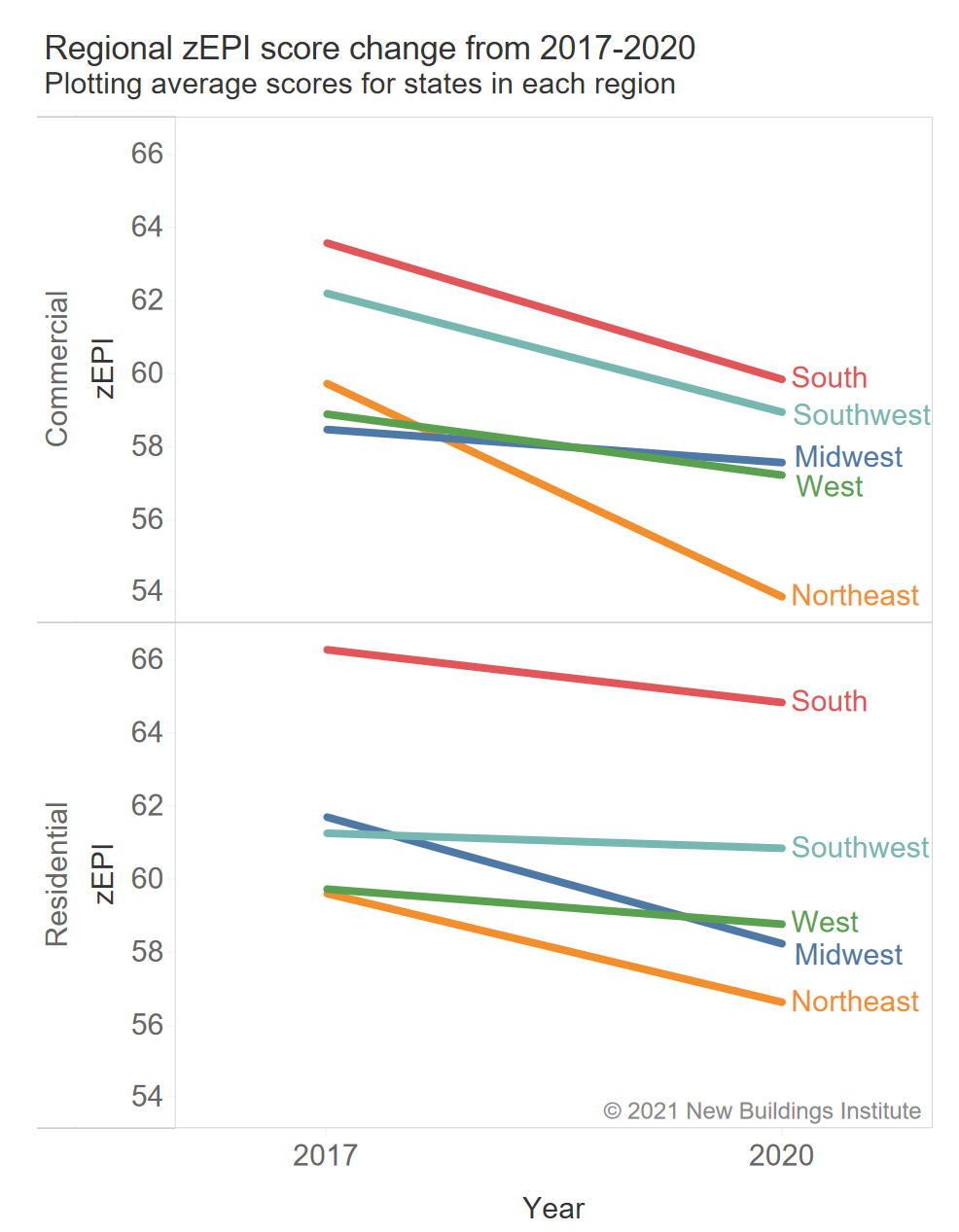ACEEE’s 2020 State Energy Efficiency Scorecard was released in December with California reclaiming the number one spot from Massachusetts. This is based on five categories including utility and public benefits, transportation, building energy efficiency, state initiatives, and appliance standards, according to ACEEE. The building energy efficiency category evaluates state energy codes and their progress toward zero energy using the Zero Energy Performance Index, or zEPI, which was first introduced to the scorecard by NBI in 2018. Zero energy homes and buildings are ones that produce as much energy as they use over the course of a year, with performance achieved through energy efficiency and renewable technologies. zEPI scores operate on a fixed scale, with 0 representing net zero performance and 100 being approximately equal to a typical building from the year 2000.
Since the scorecard started using zEPI, what progress have we seen as a whole toward zero energy?
 States make progress toward zero energy building performance by adopting more advanced energy codes, which may include the latest model energy codes (IECC or ASHRAE Standard 90) or the state’s own customized code (e.g. California Title 24 or New York Stretch), that go beyond the model energy codes in terms of building efficiency. States receive a small bonus on their zEPI scores if they allow cities or local jurisdictions to adopt stretch codes, and a modest bonus if a significant portion of those cities or jurisdictions have adopted and implemented such stretch codes. Stretch codes are typically based on the state’s code but require additional efficiency, leading to greater energy savings.
States make progress toward zero energy building performance by adopting more advanced energy codes, which may include the latest model energy codes (IECC or ASHRAE Standard 90) or the state’s own customized code (e.g. California Title 24 or New York Stretch), that go beyond the model energy codes in terms of building efficiency. States receive a small bonus on their zEPI scores if they allow cities or local jurisdictions to adopt stretch codes, and a modest bonus if a significant portion of those cities or jurisdictions have adopted and implemented such stretch codes. Stretch codes are typically based on the state’s code but require additional efficiency, leading to greater energy savings.
Building energy efficiency policies extend beyond the energy code stringency in the ACEEE State Scorecard and include code compliance and building energy use transparency. Here, we will focus just on zEPI scores to track progress toward zero energy codes (zEPI score of 0 equals zero energy). Let’s take a look at the progress the states have made, and specifically at top states leading the way. The Northeast region has pulled ahead and has the best average zEPI score in both the commercial and residential sectors, while the South has the greatest potential for improvement, particularly in the residential sector.
In the Northeast region, the leaders are Massachusetts, New York, Maryland, and Connecticut, and Vermont. These states have strong zEPI scores on both the commercial and residential sectors. This is largely down to strong code development and adoption of programs like those implemented by the Northeast Energy Efficiency Partnerships. In the U.S. more broadly, the top 10 states, when ranked by their combined commercial and residential scores are all contained within the West, Northeast, and Midwest regions.
Top 10 states based on average commercial and residential zEPI score, sorted by region and alphabetically.
| State | Region |
| Connecticut | Northeast |
| Maryland | Northeast |
| Massachusetts | Northeast |
| New York | Northeast |
| Vermont | Northeast |
| Illinois | Midwest |
| Michigan | Midwest |
| Minnesota | Midwest |
| California | West |
| Washington | West |
Though we do see progress in all regions (albeit very modest in some areas), in the grand scheme of things, states still have a very long way to go to reach zero energy codes (zEPI = 0). The most advanced energy codes in use on the market today come in around zEPI 40. As codes begin to require renewable energy generation or offsets, and as technology and cost-effective energy efficiency measures continue to develop, we can map out a rapid decline in zEPI scores taking us confidently toward a zero energy future.
By Kevin Carbonnier, Project Manager

Bio
